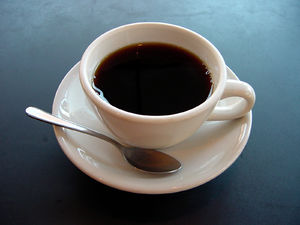Coffee: Difference between revisions
imported>Greg Woodhouse m (workgroup name) |
imported>John Stephenson (Wiki links, copyedit) |
||
| Line 1: | Line 1: | ||
[[Image:Mocha_and_donut.jpg|right|thumb|A cafe mocha (made from compressed espresso grounds, combined with steamed milk and chocolate sauce) with whipped cream on top and a glazed donut.]] | [[Image:Mocha_and_donut.jpg|right|thumb|A cafe mocha (made from compressed espresso grounds, combined with steamed [[milk]] and [[chocolate]] sauce) with whipped [[cream]] on top and a glazed donut.]] | ||
'''Coffee''', brewed from beans, is a popular drink across the entire world. | '''Coffee''', brewed from beans, is a popular drink across the entire world. Coffee beans are harvested from [[cherry|cherries]] grown from the genus of [[plant]]s known as ''Coffea''. There are over 500 genera and 6,000 [[species]] of [[tropics|tropical]] coffea [[tree]]s. | ||
A coffee cherry's outer skin is the exocarp | A coffee cherry's outer skin is the ''exocarp''; beneath it a thin layer of pulp known as ''mesocarp'', then a slimy layer called ''parenchyma''. The beans within this are covered in a thin layer named the ''endocarp''. Inside the endocarp are two beans, usually positioned next to each other, divided by a [[membrane]] called the ''spermoderm''. | ||
Although the availability of coffee is ubiquitous, coffea trees can only be grown in certain | Although the availability of coffee is ubiquitous, coffea trees can only be grown in certain [[climate]]s. The most effective places to grow coffee are in tropical or sub-tropical environments at high [[altitude]]s. Because of this, distinct places in the world are prime for coffea cultivation: [[Brazil]], [[Columbia]], [[India]], [[Indonesia]], [[Mexico]], [[Puerto Rico]], and [[Vietnam]] are the top coffea growing and exporting [[country|countries]]. | ||
Coffee can be served in a number of ways. | Coffee can be served in a number of ways. The most traditional [[Western society|Western]] method is by which the roasted beans are ground (coarse), and then placed into a paper filter, where hot [[water]] is then strained into the filter, soaking the grounds, from which the coffee drips into a coffee pot. The appliances that produce coffee in this way are known as drip-style [[coffee maker]]s, or "drip-pots" in the [[United States of America|USA]], and as coffee filter machines in [[Europe]]. | ||
[[Image:A small cup of coffee.JPG|right|thumb|A cup of coffee]] | [[Image:A small cup of coffee.JPG|right|thumb|A cup of coffee]] | ||
Greek, Turkish and other coffees emanating from the Ottoman period are made by rapidly boiling finely-ground roasted beans, along with the appropriate amount of sugar, in a special small metal pan. The resulting mix is poured into a small cup, of which only the upper liquid is drunk. The bottom third or so of the cup contains coffee grounds. | [[Greece|Greek]], [[Turkey|Turkish]] and other coffees emanating from the [[Ottoman Empire|Ottoman]] period are made by rapidly boiling finely-ground roasted beans, along with the appropriate amount of [[sugar]], in a special small metal pan. The resulting mix is poured into a small cup, of which only the upper liquid is drunk. The bottom third or so of the cup contains coffee grounds. | ||
A popular, originally Italian, way of making coffee is to finely grind heavily roasted beans and compress them into a filter. | A popular, originally [[Italy|Italian]], way of making coffee is to finely grind heavily roasted beans and compress them into a filter. Hot water is then forced through the filter, producing a concentrated form of coffee that has a very dark color and high [[caffeine]] content. This is known simply as [[espresso]], and is often served in quantities of [[ounce]]s, or "shots". These espresso machines can create pressure by either heating water up to its boiling point, creating steam to produce the concentrate, or through a pump that injects water into the compressed grounds. The amount of compression (measured in [[pound]]s/square inch (psi)) varies between the different styles of appliances. | ||
== Caffeine and the development of decaffeinated coffee in the | == Caffeine and the development of decaffeinated coffee in the West == | ||
Despite the variances in coffea plants, there is a commercial demand for decaffeinated coffee. | Despite the variances in coffea plants, there is a commercial demand for decaffeinated coffee. The two most common types of beans sold world-wide, Arabica and Robusta, do contain different levels of naturally occurring caffeine; the latter typically having more than the former. However, "decaf" (as its commonly referred to) is produced by one of two post-harvest methods. In the first, known as ''indirect'', the beans are soaked in hot water to dissolve the caffeine. The water is then treated with a chemical solvent to remove the caffeine. In order to maintain the taste or flavour constituents, the water is resprayed back into the beans. The ''direct'' method involves soaking the beans in the chemically treated water, removing the solvent from the water, and then allowing the beans to resoak. | ||
There are four different processes by which coffee can be decaffeinated<ref>{{cite web|url=http://www.equator.ca/aboutcoffee/thebean.asp|title=About Coffee, The Bean|publisher=Equator Coffee|accessdate=15-06-2007}}</ref>: | There are four different processes by which coffee can be decaffeinated<ref>{{cite web|url=http://www.equator.ca/aboutcoffee/thebean.asp|title=About Coffee, The Bean|publisher=Equator Coffee|accessdate=15-06-2007}}</ref>: | ||
* Methylene chloride (DCM): DCM is involved in the ''direct'' method of decaffeination. | *[[Methylene chloride]] (DCM): DCM is involved in the ''direct'' method of decaffeination. The disadvantages to using DCM are that it is a [[carcinogen]]ic, and an [[ozone]]-depleting [[gas]]. | ||
* Ethyl Acetate: Ethyl acetate exists in fruit naturally, but for commercial decaffeination it is produced from ethyl alcohol and acetic acid. | *[[Ethyl Acetate]]: Ethyl acetate exists in [[fruit]] naturally, but for commercial decaffeination it is produced from ethyl [[alcohol]] and [[acetic acid]]. The resulting product ''can'' be carcinogenic. | ||
* Supercritical Carbon Dioxide: the raw coffee beans are exposed to pressurized, liquid carbon dioxide. | *Supercritical [[Carbon Dioxide]]: the raw coffee beans are exposed to pressurized, liquid carbon dioxide. In an evaporator, the caffeine is drawn out by the carbon dioxide and precipitates; after a period of [[evaporation]] and re[[condensation]], the mixture is recirculated into the coffee. | ||
* Swiss Water Process: Devised by Kraft Foods Inc, | * Swiss Water Process: Devised by [[Kraft Foods Inc]], this is a chemical free process. Beans are first soaked in water, which absorbs the caffeine content. The water is passed through carbon filters which process out the caffeine. A fresh batch of beans is then soaked in the caffeine-free water, which still retains much of the flavour constituents from the previous soak. | ||
==References== | ==References== | ||
Revision as of 01:40, 31 July 2007
Coffee, brewed from beans, is a popular drink across the entire world. Coffee beans are harvested from cherries grown from the genus of plants known as Coffea. There are over 500 genera and 6,000 species of tropical coffea trees.
A coffee cherry's outer skin is the exocarp; beneath it a thin layer of pulp known as mesocarp, then a slimy layer called parenchyma. The beans within this are covered in a thin layer named the endocarp. Inside the endocarp are two beans, usually positioned next to each other, divided by a membrane called the spermoderm.
Although the availability of coffee is ubiquitous, coffea trees can only be grown in certain climates. The most effective places to grow coffee are in tropical or sub-tropical environments at high altitudes. Because of this, distinct places in the world are prime for coffea cultivation: Brazil, Columbia, India, Indonesia, Mexico, Puerto Rico, and Vietnam are the top coffea growing and exporting countries.
Coffee can be served in a number of ways. The most traditional Western method is by which the roasted beans are ground (coarse), and then placed into a paper filter, where hot water is then strained into the filter, soaking the grounds, from which the coffee drips into a coffee pot. The appliances that produce coffee in this way are known as drip-style coffee makers, or "drip-pots" in the USA, and as coffee filter machines in Europe.
Greek, Turkish and other coffees emanating from the Ottoman period are made by rapidly boiling finely-ground roasted beans, along with the appropriate amount of sugar, in a special small metal pan. The resulting mix is poured into a small cup, of which only the upper liquid is drunk. The bottom third or so of the cup contains coffee grounds.
A popular, originally Italian, way of making coffee is to finely grind heavily roasted beans and compress them into a filter. Hot water is then forced through the filter, producing a concentrated form of coffee that has a very dark color and high caffeine content. This is known simply as espresso, and is often served in quantities of ounces, or "shots". These espresso machines can create pressure by either heating water up to its boiling point, creating steam to produce the concentrate, or through a pump that injects water into the compressed grounds. The amount of compression (measured in pounds/square inch (psi)) varies between the different styles of appliances.
Caffeine and the development of decaffeinated coffee in the West
Despite the variances in coffea plants, there is a commercial demand for decaffeinated coffee. The two most common types of beans sold world-wide, Arabica and Robusta, do contain different levels of naturally occurring caffeine; the latter typically having more than the former. However, "decaf" (as its commonly referred to) is produced by one of two post-harvest methods. In the first, known as indirect, the beans are soaked in hot water to dissolve the caffeine. The water is then treated with a chemical solvent to remove the caffeine. In order to maintain the taste or flavour constituents, the water is resprayed back into the beans. The direct method involves soaking the beans in the chemically treated water, removing the solvent from the water, and then allowing the beans to resoak.
There are four different processes by which coffee can be decaffeinated[1]:
- Methylene chloride (DCM): DCM is involved in the direct method of decaffeination. The disadvantages to using DCM are that it is a carcinogenic, and an ozone-depleting gas.
- Ethyl Acetate: Ethyl acetate exists in fruit naturally, but for commercial decaffeination it is produced from ethyl alcohol and acetic acid. The resulting product can be carcinogenic.
- Supercritical Carbon Dioxide: the raw coffee beans are exposed to pressurized, liquid carbon dioxide. In an evaporator, the caffeine is drawn out by the carbon dioxide and precipitates; after a period of evaporation and recondensation, the mixture is recirculated into the coffee.
- Swiss Water Process: Devised by Kraft Foods Inc, this is a chemical free process. Beans are first soaked in water, which absorbs the caffeine content. The water is passed through carbon filters which process out the caffeine. A fresh batch of beans is then soaked in the caffeine-free water, which still retains much of the flavour constituents from the previous soak.
References
- ↑ About Coffee, The Bean. Equator Coffee. Retrieved on 15-06-2007.

